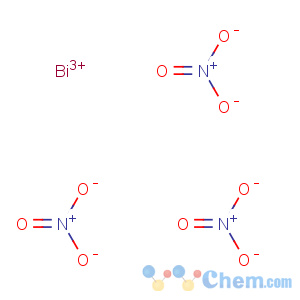Title: Bismuth Subnitrate
CAS Registry Number: 1304-85-4
CAS Name: Bismuth hydroxide nitrate oxide (Bi5(OH)9(NO3)4O)
Synonyms: bismuth nitrate basic; bismuth oxynitrate; bismuth subnitricum; bismuthyl nitrate; bismuth white; magistery of bismuth; novismuth; paint white; Spanish white
Molecular Formula: Bi5H9N4O22
Molecular Weight: 1461.99
Percent Composition: Bi 71.47%, H 0.62%, N 3.83%, O 24.08%
Literature References: A basic salt, the compn of which varies with the conditions of preparation. Contains 70 to 74% Bi or 79 to 82% Bi2O3. Prepd by partial hydrolysis of Bi(NO3)3:
Gmelins, Bismuth (8th ed.)
19, pp 132-135 (1927);
Traité Pharm. Chim. vol. 1, P. Lebeau, M. M. Janot, Eds. (Masson, Paris, 1956) p 371;
Handbuch der Pharmazie vol. 4(1), H. Thoms, Ed. (Urban & Schwarzenberg, Berlin, 1927) p 325. Mechanism of action study: S. Pugh, M. R. Lewin,
J. Gastroenterol. Hepatol. 5, 382 (1990). Clinical studies in ulcer caused by
Helicobacter pylori infection: A. F. Carvalho
et al., Aliment. Pharmacol. Ther. 12, 557 (1998); M. W. Whitehead
et al., Helicobacter 5, 169 (2000); R. H. Phillips
et al., ibid. 176.
Properties: Odorless, tasteless, heavy, slightly hygroscopic, microcrystalline powder. Dec to Bi2O3 and nitrogen oxides when heated to red heat. Practically insol in water, alc. Sol in dil HCl and HNO3.
Keep well closed and protect from light. Incompat. Alkaline bicarbonates, soluble iodides, gallic acid, calomel, salicylic acid, tannin, sulfur.
Use: Manuf bismuth fluxes for enamels; in cosmetics.
Therap-Cat: Antacid; antiulcerative.
Therap-Cat-Vet: See Bismuth.
Keywords: Antacid; Antiulcerative.

